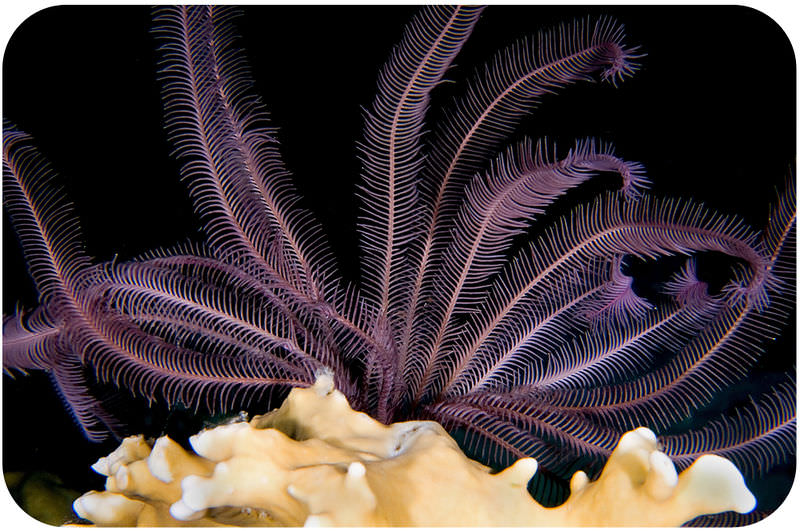9.21: Types of Echinoderms
- Page ID
- 14156

How can you find feathers in the ocean?
Birds aren't the only creatures that have feathers. One type of echinoderm, the feather star, has feathery arms. These animals don't fly or even move much at all. They usually cling to rocks, using a root-like structure.
Types of Echinoderms
The echinoderms can be divided into two major groups:
- Eleutherozoa are the echinoderms that can move. This group includes the starfish and most other echinoderms.
- Pelmatozoa are the immobile echinoderms. This group includes crinoids, such as the feather stars.
Listed below are the four main classes of echinoderms present in the Eleutherozoa Group (Table below).
| Class | Representative Organisms | Characteristics |
|---|---|---|
| Asteroidea | Starfish and asteroids | Capture prey for their own food. |
| Ophiuroidea | Brittle stars (Figure below) | Bottom feeders with long, narrow, flexible arms that allow relatively fast movement. |
| Echinoidea | Sea urchins and sand dollars | Have movable spines which are used for movement, defense, and sensing the environment. |
| Holothuroidea | Sea cucumbers | Armless, elongated, generally soft-bodied animals. |

Habitat
Echinoderms are spread all over the world at almost all depths, latitudes, and environments in the ocean. Most feather stars (crinoids) live in shallow water. In the deep ocean, sea cucumbers are common, sometimes making up 90% of the organisms. Most echinoderms, however, are found in reefs just lying beneath the surface of the water. No echinoderms are found in freshwater habitats or on land. This makes Echinodermata the largest animal phylum to only have ocean-based species.
Do Echinoderms Move?
While almost all echinoderms live on the sea floor, some sea-lilies can swim at great speeds for brief periods of time, and a few sea cucumbers are fully floating. Some echinoderms find other ways of moving. For example, crinoids attach themselves to floating logs, and some sea cucumbers move by attaching to the sides of fish.
On the underside side of a sea star, there are hundreds of tiny feet usually arranged into several rows on each ray of the star. These are called tube feet, or podia, and are filled with seawater in most echinoderms. The water vascular system within the body of the animal is also filled with seawater. By expanding and contracting chambers within the water vascular system, the echinoderm can force water into certain tube feet to extend them. The animal has muscles in the tube feet, which are used to retract them. By expanding and retracting the right tube feet in the proper order, the animal can walk.
Summary
- Echinoderms include the star fish, sea urchins, sand dollars, and feather stars.
- Echinoderms are found in many different ocean environments, but most are found in reefs.
Explore More
Use the resources below to answer the questions that follow.
Explore More I
- Feather Stars and Sea Lilies at http://www.youtube.com/watch?v=IFWeqDcAYGk (1:49)
- What is the difference between sea lilies and feather stars?
- Some crinoids can be seen at night in shallow tropical waters, but where have they been found to be most abundant?
Explore More II
- Brittle Star Food Fight at http://www.youtube.com/watch?v=Myhp8ifW6ig (1:59)
- What kind of feeding behavior are these brittle stars displaying?
- How is this feeding behavior related to the ecosystem in which they live?
Explore More III
- Sea cucumbers at National Geographic http://animals.nationalgeographic.com/animals/invertebrates/sea-cucumber/
- Where do sea cucumbers live?
- How do sea cucumbers eat?
Review
- Name five examples of echinoderms.
- Where are most echinoderms found?
- Describe the land-based echinoderms.
- How do sea stars move?

